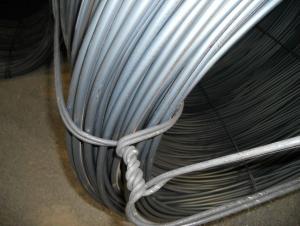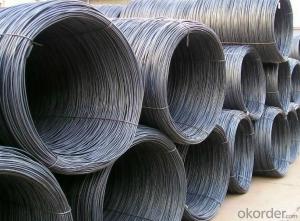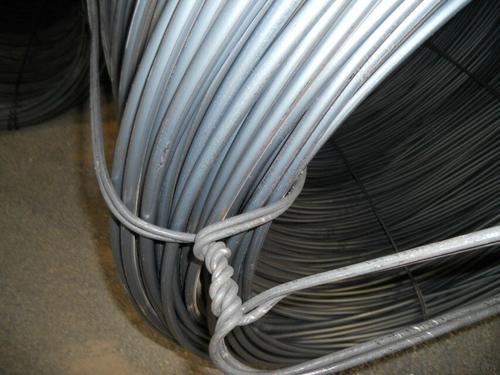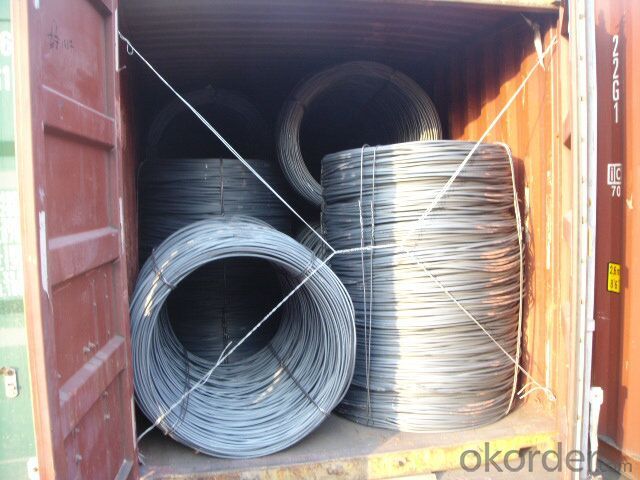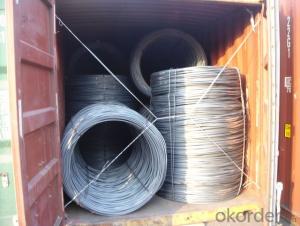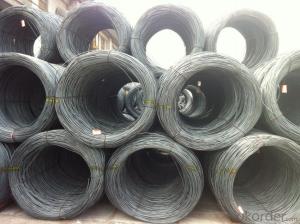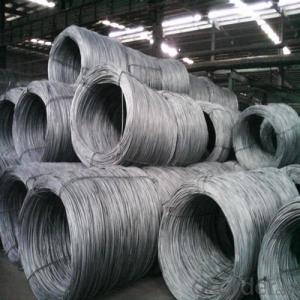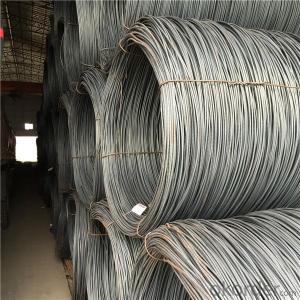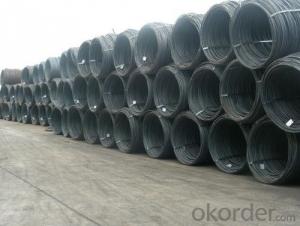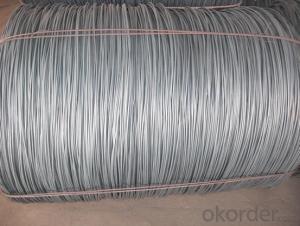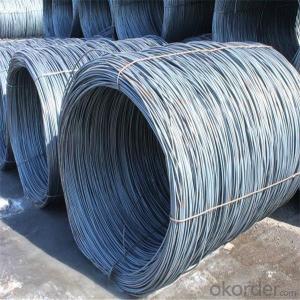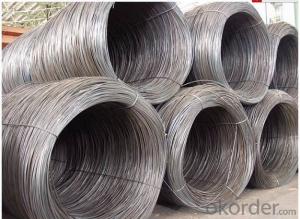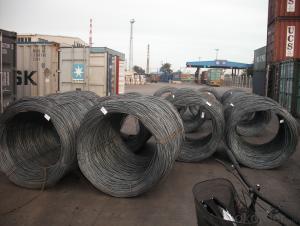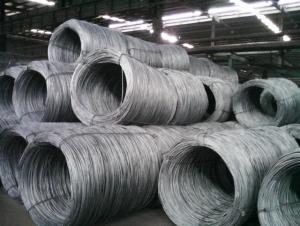Steel Wire Rod from 5.5mm to 14mm thickness Cold-heading
- Loading Port:
- Tianjin
- Payment Terms:
- TT OR LC
- Min Order Qty:
- 30 m.t.
- Supply Capability:
- 100000 m.t./month
OKorder Service Pledge
OKorder Financial Service
You Might Also Like
Specification
Product Description of Steel Wire Rod from 5.5mm to 14mm thickness Cold-heading
OKorder is offering Steel Wire Rod from 5.5mm to 14mm thickness Cold-heading at great prices with worldwide shipping. Our supplier is a world-class manufacturer of steel, with our products utilized the world over. OKorder annually supplies products to European, North American and Asian markets. We provide quotations within 24 hours of receiving an inquiry and guarantee competitive prices.
Specifications of Steel Wire Rod from 5.5mm to 14mm thickness Cold-heading
Steel Grade: Q195/235, SAE1006-1018B
Standard: ASTM, GB
Diameter: 5.5mm, 6.5mm, 7mm,8mm,9mm,10mm,12mm,14mm
Diameter tolerance: ±0.3mm
Type: in coil, coil weight around 2MT
Place of Origin: China Mainland
Surface: round, no twisted, light and smooth
Chemical Composition of Steel Wire Rod from 5.5mm to 14mm thickness Cold-heading
Trademark | Rank | Chemical composition (quality score) % | |||||
C | Si | Mn | S | P | |||
≤ | ≤ | ≤ | |||||
Q195 | 0.06-0.12 | 0.30 | 0.25 | 0.050 | 0.045 | ||
Q235 | A | 0.14-0.22 | 0.30 | 0.30-0.65 | 0.050 | 0.045 | |
Q235 | B | 0.12-0.20 | 0.30 | 0.30-0.70 | 0.045 | 0.045 | |
Trademark | Rank | Pulling Test | |||||
Bend PointΔs/Mpa | Tensile Strength | Elongation Ratioδ5% | |||||
Thickness (Diameter) /MM | Thickness (Diameter) /MM | ||||||
≤16 | 16-40 | ≤16 | 16-40 | ||||
≥ | ≥ | ||||||
Q195 | 195 | 185 | 315-390 | 33 | 32 | ||
Q235 | A | 235 | 225 | 375-500 | 26 | 25 | |
Q235 | B | 235 | 225 | 375-500 | 26 | 25 | |
Usage and Applications of Steel Wire Rod from 5.5mm to 14mm thickness Cold-heading
It is mainly used for reinforcement of reinforced concrete and welded structure or reprocessed (roberts , nail, etc.) materials, especially used to produce wire drawing, welding electrode, nails, spring, electronic, precise machinery parts and so on.
Packaging & Delivery of Steel Wire Rod from 5.5mm to 14mm thickness Cold-heading
Packaging Detail: products are packed in coil, each coil weight around 2 MT, and then shipped by container or bulk vessel
Delivery Detail: within 45 days after received deposit or LC.
Label: to be specified by customer, generally, each bundle has 1-2 labels
Note:
1. Our products are produced according to national standard (GB), if not, supply according to national standards (GB) or agreement as customer required.
2. Other Grade and Standard carbon steel wire rod we can supply:
Grade:H08A, 30MnSi, 62B-82B
Standard: AISI, BS, JIS, DIN
3. We can supply all kinds of building materials; if you need anything about building materials, please contact us.
4. Please send us your detail specifications when inquire. We will reply to you as soon as possible.

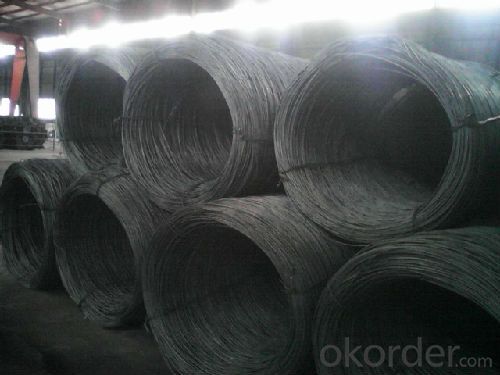
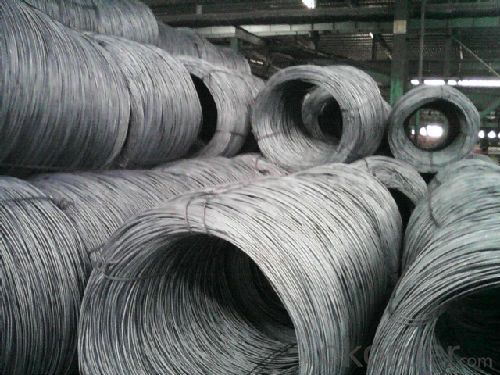
- Q: How is steel wire rod tested for wear resistance?
- Steel wire rod is tested for wear resistance through various methods. One common approach is conducting a series of wear tests, such as the pin-on-disc test or the dry sand/rubber wheel abrasion test. These tests involve subjecting the wire rod to controlled friction or abrasive forces to simulate real-world wear conditions. The wear rate, coefficient of friction, and other parameters are then measured and analyzed to assess the wire rod's resistance to wear. Additionally, microstructural analysis and hardness testing may also be performed to evaluate the material's durability and resistance to deformation.
- Q: What are the properties of steel wire rod?
- Steel wire rods have several properties that make them highly versatile and useful in various applications. Firstly, they possess excellent strength and durability, making them ideal for applications where high tensile strength is required. Secondly, steel wire rods have good flexibility, allowing them to be easily shaped and formed into different configurations. Additionally, they have a high melting point, enabling them to withstand extreme temperatures without losing their structural integrity. Moreover, steel wire rods exhibit good corrosion resistance, making them suitable for outdoor and marine environments. Lastly, they have excellent electrical and thermal conductivity, making them suitable for applications in the electrical and electronics industries.
- Q: What are the advantages of using steel wire rod in mechanical components?
- There are several advantages of using steel wire rod in mechanical components. Firstly, steel wire rod offers high strength and durability, making it capable of withstanding heavy loads and providing excellent structural support. Secondly, steel wire rod has good flexibility and elasticity, allowing for easy bending and shaping, which is crucial in designing complex mechanical components. Additionally, steel wire rod is highly resistant to corrosion, ensuring the longevity and reliability of the components even in harsh environments. Furthermore, steel wire rod is readily available and cost-effective, making it a preferred choice for various industrial applications. Overall, the use of steel wire rod in mechanical components enhances their performance, longevity, and cost-efficiency.
- Q: What are the main factors influencing the choice of steel wire rod after-sales service?
- The choice of steel wire rod after-sales service is influenced by several main factors. Firstly, the quality of the service provided plays a crucial role. Customers expect prompt and effective after-sales support, including timely response to inquiries, technical assistance, and problem resolution. A reliable after-sales service ensures customer satisfaction and builds trust in the supplier. Secondly, the availability and accessibility of spare parts and components are important considerations. If a customer encounters any issues with the steel wire rod, they would expect the supplier to have a readily available stock of spare parts to quickly address the problem. This minimizes downtime and ensures uninterrupted production. Additionally, the expertise and knowledge of the after-sales service team are critical factors. Customers value suppliers that have well-trained and experienced service technicians who can provide expert advice and guidance. This helps customers optimize the performance of the steel wire rod and address any operational challenges they may face. Another influential factor is the cost-effectiveness of the after-sales service. Customers look for service packages that offer value for money, including reasonable prices for spare parts, maintenance contracts, and repair services. A cost-effective after-sales service ensures that customers receive the necessary support without incurring significant additional expenses. Furthermore, the geographical coverage and response time of the after-sales service team are considered. Customers prefer suppliers with a wide service network, enabling them to receive support even in remote locations. Additionally, a fast response time is crucial to minimize production downtime and maintain efficient operations. Lastly, customer feedback and reputation also influence the choice of steel wire rod after-sales service. Positive testimonials and references from existing customers can instill confidence in potential buyers. Therefore, suppliers who consistently receive positive feedback and have a strong reputation for excellent after-sales service are more likely to be preferred. In conclusion, the main factors influencing the choice of steel wire rod after-sales service include the quality of service, availability of spare parts, expertise of the service team, cost-effectiveness, geographical coverage, and reputation. By considering these factors, customers can make an informed decision and choose a supplier that meets their after-sales service expectations.
- Q: What are the common raw materials used in steel wire rod production?
- The common raw materials used in steel wire rod production are iron ore, coal, limestone, and scrap metal.
- Q: What is the chemical composition of steel wire rod?
- The chemical composition of steel wire rod typically includes iron, carbon, manganese, silicon, and small amounts of other elements such as sulfur and phosphorus.
- Q: How is steel wire rod used in the production of wire for musical instruments?
- Steel wire rod is used in the production of wire for musical instruments as it provides the necessary strength and durability required for the strings. Through a series of processes such as drawing, annealing, and coating, the steel wire rod is transformed into thin and flexible wire that can be used for guitar, piano, or violin strings. The quality of the steel wire rod directly affects the sound quality and longevity of the instrument's strings, making it an essential component in their production.
- Q: What are the different types of steel wire rod coatings used for increased adhesion?
- There are several types of steel wire rod coatings that are commonly used to enhance adhesion. These coatings are applied to the surface of the wire rod to improve its ability to bond with other materials. One of the most commonly used coatings is zinc coating, also known as galvanizing. This involves immersing the wire rod in a bath of molten zinc, which forms a protective layer on the surface of the steel. Zinc coating not only enhances adhesion but also provides corrosion resistance, making it suitable for outdoor applications. Another popular coating is copper coating. This involves electroplating the wire rod with a layer of copper, which enhances adhesion and improves conductivity. Copper coating is often used in electrical applications where a strong and reliable bond is required. Phosphate coating is another type of coating used for increased adhesion. This involves treating the wire rod with a solution containing phosphoric acid and other chemicals, which create a thin layer of phosphate crystals on the surface. Phosphate coating improves adhesion by providing a roughened surface for better bonding. Polymer coating is also used to enhance adhesion in certain applications. This involves applying a layer of polymer material, such as polyethylene or polyvinyl chloride (PVC), to the wire rod. Polymer coatings provide a strong bond with other materials and can also provide additional benefits such as insulation or protection against chemicals. In summary, the different types of steel wire rod coatings used for increased adhesion include zinc coating, copper coating, phosphate coating, and polymer coating. Each of these coatings has its own unique properties and is suitable for specific applications where improved adhesion is required.
- Q: What are the common industry guidelines for steel wire rod distributors?
- The common industry guidelines for steel wire rod distributors include ensuring product quality and adherence to international standards, maintaining a reliable and efficient supply chain, implementing strict quality control measures, providing timely deliveries, offering competitive pricing, and maintaining strong relationships with customers through effective communication and support.
- Q: How is steel wire rod used in the manufacturing of wire for electrical grounding systems?
- Steel wire rod is an essential component in the manufacturing of wire for electrical grounding systems. These systems play a crucial role in ensuring the safety and functionality of electrical installations by providing a path for electrical currents to flow into the ground, thus preventing damage or electrical shocks. In the manufacturing process, steel wire rods are first subjected to a series of shaping and forming operations. The wire rods are typically drawn through a series of dies to reduce their diameter and achieve the desired thickness. This drawing process helps in strengthening the wire and ensuring uniformity in its dimensions. The steel wire rods used for electrical grounding systems are generally made of high-quality carbon or stainless steel to ensure durability and resistance to corrosion. Once the steel wire rods have been drawn into the desired wire size, they are then subjected to various surface treatments. These treatments can include galvanization, which involves coating the wire with a layer of zinc to enhance its corrosion resistance. Galvanization also improves the electrical conductivity of the wire, making it more efficient for grounding purposes. After the surface treatment, the wire is then cut into specific lengths and spooled onto reels or coils. These wire coils are then used in the manufacturing of electrical grounding systems, such as grounding cables, conductors, or earth electrodes. The steel wire serves as the core component, providing strength and stability to the grounding system. The wire manufactured from steel wire rod is highly versatile and can be used in various electrical grounding applications, ranging from residential and commercial buildings to industrial facilities. It is commonly used for grounding electrical equipment, machinery, and infrastructure, ensuring the safe dissipation of electrical currents. In summary, steel wire rod is a fundamental material in the production of wire for electrical grounding systems. Its strength, durability, and resistance to corrosion make it an ideal choice for ensuring the safety and functionality of electrical installations.
Send your message to us
Steel Wire Rod from 5.5mm to 14mm thickness Cold-heading
- Loading Port:
- Tianjin
- Payment Terms:
- TT OR LC
- Min Order Qty:
- 30 m.t.
- Supply Capability:
- 100000 m.t./month
OKorder Service Pledge
OKorder Financial Service
Similar products
Hot products
Hot Searches
Related keywords
